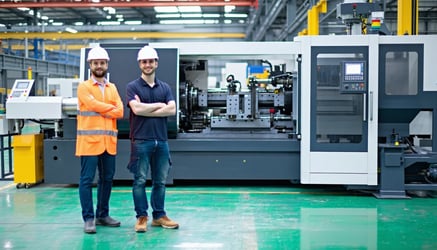In aerospace manufacturing, where tolerances are tight and part integrity is non-negotiable, few things can derail production faster than a contaminated material changeover.
Whether you're molding PEEK, Ultem™, PEI, or other super-engineering resins, switching materials isn't just a routine process—it’s a critical control point. Done wrong, it can lead to hours of downtime, scrapped parts, and long-term equipment damage.
But with the right purging process, even the most challenging transitions can be managed cleanly and efficiently.
Let’s break down how to master your next material changeover in aerospace injection molding—without the headaches.
The Challenge: High Stakes, High Temps
Aerospace components often require resins with extreme performance characteristics—high heat resistance, flame retardance, chemical durability, and structural integrity. That means processors frequently work with materials like:
- PEEK
- PEKK
- Ultem™ (PEI)
- PPS
- LCPs
These super-engineering resins typically run at processing temperatures between 650°F and 800°F. At these levels, even minor mistakes—like pausing a machine too long or failing to clean properly—can lead to severe degradation, black specks, or even hard shutdowns requiring full teardown.
Worse yet, trying to jump from one high-temp resin to a lower-temp one (or vice versa) without a plan can result in freezing, layering, and cross-contamination that may not show up until you’ve already shipped parts.
Why Traditional Changeover Methods Fall Short
A common approach in many molding shops is to chase the outgoing resin with the next one and “hope for the best.” In aerospace work, though, that’s a gamble you can’t afford.
Why? Because:
- Super-engineering resins are too expensive to waste
- Many resins degrade rapidly if left in the barrel too long
- Some resins don’t displace each other cleanly, especially with mismatched temperatures
- A single missed contaminant can compromise part performance or regulatory compliance
This is where a purpose-built purging strategy makes all the difference.
Best Practices for High-Performance Changeovers
✅ Use High-Temperature Purging Compounds
Not all purge compounds are built for aerospace-grade resins. You need one that:
- Works at 700°F+ without breaking down or oxidizing
- Matches the viscosity range of your processing resin
- Has strong detergency to remove residue and carbon
- Can seal the machine safely during planned shutdowns
A purge compound that breaks down under heat or leaves residue behind will only add to your contamination risk.
✅ Follow a Two-Step Purge for Temperature Transitions
If you're switching between resins with vastly different processing temps, a two-step process is best:
- Step 1 – Purge the high-temp resin (e.g., PEEK) with a high-temp purging compound. Slowly begin lowering the barrel temperature.
- Step 2 – Once you're within the processing range of your next material, run a general-purpose or lower-temp purge to clean any remaining purge compound.
This prevents premature cooling and layering that could cause buildup or black specs down the road.
✅ Train Your Team on Changeover Procedures
Consistency matters—especially across shifts. Document and enforce a clear SOP that covers:
- Which purge to use for which resins
- Proper purge volume and sequence
- Temperature ramp-up and ramp-down rates
- Sealing procedures for downtime
You’ll avoid variation and reduce trial-and-error between operators.
The Cost of Getting It Wrong
In aerospace, the cost of a poor material changeover isn’t just measured in downtime. It can also include:
- Rejected parts that don’t meet spec
- Customer complaints tied to surface defects or mechanical failures
- Extended equipment downtime due to screw pulls or manual cleaning
- Lost material—some super-engineering resins cost more than $30/lb
- Regulatory risk if contamination leads to part failure in critical systems
With thinner margins and tighter quality controls than ever, avoiding those risks is mission-critical.
Final Thoughts
Mastering material changeovers in aerospace molding comes down to more than just skill—it requires a repeatable, optimized purging process that keeps machines clean, materials pure, and changeovers efficient.
Whether you're running high-temperature PEEK or transitioning to a lower-temp resin like ABS, the key is having the right purging compounds, process steps, and team training in place.
It’s not just about cleaning your machine. It’s about protecting your parts, your customers, and your reputation.
Ready to see the difference Asaclean® can make in your production? Request a free sample today and experience how our purging compounds can enhance your color change efficiency, reduce waste, and improve your manufacturing process. Our team of experts is here to guide you through the process and help you achieve the best results. Contact us now to get started!

Tom Hanvey is the Associate Director of Marketing & Sustainability at Plastics North America. Before joining APNA, he worked as the Senior Marketing Manager for Asaclean Purging Compounds. He's worked in the plastics industry for over 10 years and focuses on recyclable resins and on the inbound marketing side, providing easy-to-digest content to processors looking for an edge on their competition.








Comments